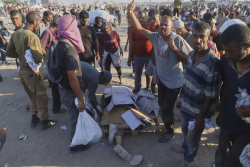Trump’s early declaration of a durable peace in the Middle East appears to be giving way to a multi-sided military buildup.
During a press conference at the White House on Friday afternoon, President Donald Trump made headlines when he reiterated America’s ability—and its right—to bomb targets inside Iran at will. This sparked a flurry of news stories that has carried on throughout the weekend.
Why was Trump saying this? Was he even serious?
The Middle East Is Far from Quiet
Trump was probably saying that in response to a series of actions taken both by Israel and Iran in the days since Trump successfully brokered a ceasefire between the two warring parties. No, Trump does not seek to restart hostilities in the region.
Then again, he might not have a choice.
It has barely been a week since the ceasefire between Israel and Iran, and already it appears to be breaking down—at least along the periphery. Late last week, when everyone thought the Mideast had finally quieted down, Israeli warplanes began dropping bombs on Lebanon. Clearly, the Israelis were bombing suspected Hezbollah targets.
These strikes came on the heels of three interesting developments. The first was that Israel’s military leaders announced that they were going to take on the “Lebanonization strategy” and apply it to Iran. In other words, Israel reserved the right to re-strike any suspicious target in Iran at will—and Israel would maintain the capabilities to do so, even as Iran is clearly rebuilding its forces after the war.
The second development came in the form of rumors from Syria, in which the Islamist regime there appeared to condone the Israeli annexation of the Golan Heights—allowing for Israel to permanently expand its defensive perimeter into Syria itself.
Finally—and shortly before Israel began bombing Lebanon—an Israeli high court finally indicted Prime Minister Benjamin Netanyahu on corruption charges following a multi-year investigation. The indictment was widely expected, but it prompted Trump to voice his support to Netanyahu on Truth Social, likening the Israeli judiciary’s attack on Netanyahu to the criminal prosecution of Trump during the 2024 presidential campaign.
What’s Netanyahu’s Real Endgame?
These three developments are key to understanding what is happening with Israel in the Middle East. Clearly, Jerusalem is not content with the ceasefire between itself and Iran. By smashing Hezbollah targets in Lebanon, Israel is trying to weaken whatever reach Iran has into Israel’s proverbial backyard.
Meanwhile, there are fears that Netanyahu is escalating militarily as a sort of “wag the dog” moment, seeing as this unexpected military action took place only hours after the Israeli court indicted Netanyahu.
What’s more, in keeping with their vow to re-strike Iranian targets whenever they wanted to, Israel’s potential official annexation of the Golan Heights is part of Israel’s need to maintain a secure air corridor through Syria to allow for their planes to reliably fly through on their way to and fro Iran. Again, though, these are only rumors about the Golan Heights.
Israel’s Airstrikes Have Not Deterred Iran
At the other end of the Middle East, in Iran, there are also strange occurrences at the leadership level. During the height of the war, Supreme Leader Ali Khamenei was—and likely remains—a target of Israel’s military. So Khamenei handed over operational control of much of the country to his military leaders—notably the commanders of the Islamic Revolutionary Guards Corps (IRGC).
Because Khamenei was a target of Israel, his security forces stashed him away in a bunker at an undisclosed location. Moreover, to prevent the Israelis from doing to him what they did a year ago to Hezbollah leaders during the so-called “Pager Operation,” Iranian security forces ordered all electronic communication devices banned from the bunker where Khamenei is hiding.
In other words, much like Osama bin Laden in his final years, the Ayatollah is having to rely on couriers coming to and from his bunker to pass along news and orders. Therefore, Khamenei has effectively lost control over his country. His military—and in particular his ideological army, the IRGC—is running Iran now.
To complicate matters further, the Iranians have announced that they were undeterred by the American airstrikes on their nuclear facilities—and intend on restarting their nuclear weapons development program once more. In fact, it appears that Isfahan, the site that the US Navy fired 30 Tomahawk cruise missiles at, is already being reopened, according to unconfirmed reports.
A Middle East “Peace In Our Time?” Not Likely
Whatever the case may be, given that satellite photos taken two days before the American airstrikes commenced show convoys of trucks leaving the facilities that were targeted by US airstrikes, many in the US postulate that much of Iran’s highly enriched uranium may have been evacuated before the US attacked the sites.
Add to the mix that Iran is on a buying spree in Beijing, purchasing advanced Chinese warplanes and weapons to replace the systems they lost—and to make up for the lack of Russian systems. Trump’s early declaration of a durable peace in the Middle East appears to be giving way to a military buildup, in which all sides understand another war is coming and hope to position themselves well when it does.
About the Author: Brandon J. Weichert
Brandon J. Weichert, a Senior National Security Editor at The National Interest as well as a contributor at Popular Mechanics, who consults regularly with various government institutions and private organizations on geopolitical issues. Weichert’s writings have appeared in multiple publications, including the Washington Times, National Review, The American Spectator, MSN, the Asia Times, and countless others. His books include Winning Space: How America Remains a Superpower, Biohacked: China’s Race to Control Life, and The Shadow War: Iran’s Quest for Supremacy. His newest book, A Disaster of Our Own Making: How the West Lost Ukraine is available for purchase wherever books are sold. He can be followed via Twitter @WeTheBrandon.
Image: Shutterstock / mijansk786.
















